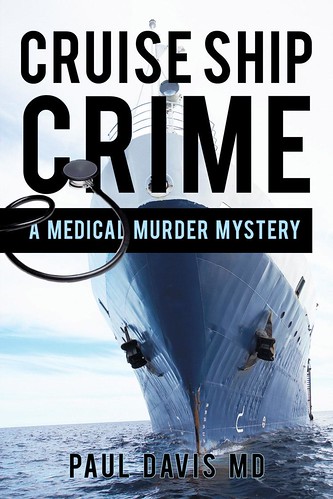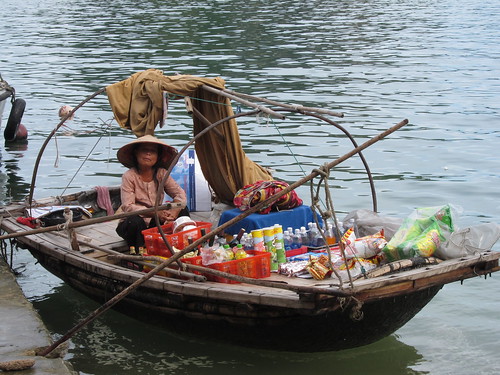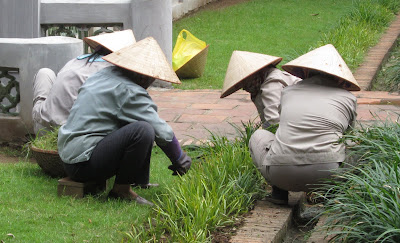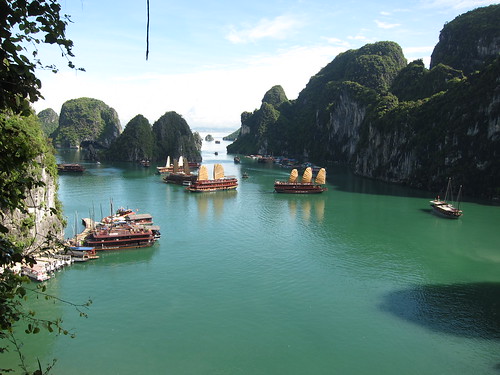Down the Mekong
Down the Mekong
By Skye Wentworth
Entertainment Editor, Wandering Educators
Paul Davis, MD is a doctor and author of a new book, Cruise Ship Crime: A Medical Murder Mystery. Trained in Family Practice and Emergency Medicine in Canada, the United Kingdom, and the United States, Dr. Davis uses his insider knowledge, as his novels are based on his ten-year career as a cruise ship doctor. He has seen a lot over the years and the experience is reflected in his work and the effortless way he turns the cruise ship into a self-contained social universe with deep secrets and seemingly infinite possibilities among the passengers on board.
In Cruise Ship Crime, Dr. Alan Mayhew is a retired cruise ship doctor who’s about to go on—a cruise! He’s grieving the loss of his wife, and his family feels a cruise is just what he needs to move on—to take his mind off of missing her. Once on board, he meets some of the eclectic folks that make up the passengers and the crew including Tiffany, the beautiful cruise ship director. With her, Dr. Mayhew helps solve a series of on board crimes, including a murder.

In August 2010, Paul traveled the Mekong River, doctor by day and author by night. Dr. Paul Davis gave several book readings at hotels in Hanoi, Viet Nam and Siem Reap, Cambodia. Below is an account of his river cruise, which I have edited from his notes.

Down the Mekong
Paul Davis, MD
On August 1st, I flew to Viet Nam to spend 2 nights in Hanoi, an overnight in Ha Long Bay, and a two night stay in Siem Reap before embarking on our Mekong River cruise, ending our journey with an overnight stay in Ho Chi Minh City (Saigon).
Apparently the Vietnamese have been doing this type of murmur cruise on the Mekong ever since the late 1800s. What’s to say about this meandering riverboat adventure down its waterways? To tell you that the Mekong River is the longest river in Southeast Asia and supports the lives of 70 million people from Tibet to Vietnam is not enough. Should I tell you that in terms of historic, cultural and ecological richness – the Mekong has no equal? The sagas of ancient empires, colonial powers and modern conflicts have unfolded along her banks. Yes, and through it all, the Mekong remains first and foremost a lifeline. Temples, trade routes and fishing villages in the river’s path are today untouched by time, just as the way of life they represent.

My first book event for Cruise Ship Crime: a Medical Murder Mystery was at the Sofitel Metropole Hotel in Hanoi -- one of the prettiest and most luxurious hotels in the world. The book reading was held in the early evening, August 2nd, and it was terrific fun to leisurely discuss the book with a handful of people and enjoy cocktails by the pool.
After breakfast the following day, we set sail to discover Ha Long Bay’s magnificent scenery set amidst stunning limestone cliffs. That evening we enjoyed a dinner and slept onboard our traditional wooden Junk.

Another day, another terrific breakfast and we departed Hanoi, driving six hours downstream and later walking over a gravel path to get to our river cruise ship that was moored on the side of a farmer’s hut. It was supposed to be docked a few miles from Siem Reap, Cambodia but because the Chinese built a hydro-power dam upstream on the Mekong and the drier than normal year, the central lake and the rivers are very low. Consequently, farmers are not able to grow their rice or even get to the river for water — not to mention that they are also facing encroachment of salt water.
Our home for the next 11 days was a welcome site. We boarded the immaculate MS La Marguerite, which was specifically built to provide the most luxurious and immersive experience on South East Asia’s legendary Mekong River. With a design that combines colonial elegance with local artifacts and regional Mekong touches, this ship proved to be a perfect setting for an unforgettable river odyssey. And the food was fresh and delicious.

La Marguerite Riverboat
As we headed toward Siem Reap, we encountered a timeless world of tranquil rice paddies, traditional floating villages, and grand pagodas and palaces that recalls the glories of bygone kingdoms and empires.
On land we discovered that Siem Reap has but one objective: bring in the tourists! Guesthouses, colonial bars, top-of-the line restaurants, cheap eating-places, souvenir or silk shops, art galleries and massage parlors are flourishing more or less. Being a popular tourist destination, Siem Reap also has a large number of hotels. I gave a book reading at the Le Meridien Angkor hotel, which sports an ordinary-looking exterior, however, the inside feels like a slick, modern big city hotel.
We woke up the following morning aboard the MV Marguerite to Wat Hanchey, a hilltop pagoda overlooking the Mekong River. After breakfast we met with our guides and set off to explore Wat Hanchey.
We walked up a steep hill to the pagoda and found ancient structures representing quintessential Chenla Empire architecture, dating back to the eight century. This predates the infamous Angkor Empire, which included Cambodia, most of Vietnam, Laos and a good portion of Thailand.
Unlike Angor Wat, which had cues waiting to get in to the archaeological sites and scores of buses filled mostly with pushy Japanese and Korean tourists, we were relieved to find not many tourists at all. At the top, we turned around and witnessed a beautiful panoramic view over the Mekong River and a very large island sitting right smack in the middle.
There are many old structures on the site but Wat Hanchey also has relatively new structures, including some very large cement statues of fruit. Fruit? This region is very lush and tropical and provides many tropical fruits. Fruit is one of the reasons that this area of Cambodia is one of the more wealthy areas of the country. The six-foot plus size statues of fruit are very colorful and give the entire area a bit of a carnival atmosphere. There are also quite a few statues of animals – mostly jungle animals. The only real ones we saw were humans and one very large monkey. The monkey was quite the character hanging from a tree and being quite selective of the handouts that were offered to him. I noticed he particularly liked carrots, potato chips, and some sort of sticky rice candy that folks were doling out.
As with many of the temples in Cambodia, there is a combination of Hindu and Buddhist temples. The most current religion practiced there being Buddhist. One of the old temples, somewhat well preserved, was originally Hindu and had its offerings area with the Lingus, and an area for the milk to be received. Right alongside this temple was a very beautiful Buddhist temple with carvings of snakes and imaginary animals. There were many stunning paintings and Buddhas, and of course lots of candles and offerings of flowers. We spotted many monks in yellow and orange saffron robes walking around the grounds of this hilltop temple. With shoes off, one was able to enter one of the main religious areas, already filled with people from the local villages who had come up for the day to listen to the Buddhist Monk give his prayers by loudspeaker. All-and-all, I found it to be a fascinating collection of humanity and was reminded that during the pre-Angkor Chenla Empire, Wat Hanchey was an important religious center.

As we headed back to the boat, our guides let us know that we’d be taking a short river trip down the river to visit Kampong Cham. The cruise immersed us in the local culture and we deeply sensed that the Mekong is integral to the lives of the Cambodians. Many are born, live and die on the water, eating a diet of fish and corn or rice grown on patches of land when the water recedes.
Another day brings us to Phnom Penh, a very large city with nearly three million inhabitants on the banks of the Mekong River. This commercial, political and cultural hub of Cambodia retains its French influence. Its old colonial architecture defines an attractive backdrop to busy cafes and shops.
The Royal Palace, the attractive Silver Pagoda and the National Museum are some of the highlights that display the richness of Khmer culture. For example there is one Buddha statute made of pure gold, which has nearly 10,000 diamonds attached to it. He weighs over 200 pounds. They’re many other beautiful pieces of art, which have undoubtedly been gifted to the kings over the centuries.
In stark contrast to the beauty of the Royal Palace, we took a bus out to the Killing Fields or shall I say, one of the killing fields, as there were a number of sites in Cambodia where large numbers of people were killed and buried by the time Khmer Rouge regime during the rule of Pol Pot during 1975-1979. Most of the estimates of the total number of deaths resulting from Khmer Rouge regime, including disease starvation, and the actual torture and order of civilians range anywhere from 2-2.2 million individuals.
Emerging from a violent past of human rights atrocities, war and political instability, Cambodia is recovering from its past and slowly becoming a top destination on the South East Asian travel map. Travelers to Cambodia can now enjoy many wonderful aspects of this country. Pleasurable moments can be had in the snatches of friendly conversations, in the tranquility ushered in by Buddhist prayer or in the sounds of workers in the rice paddies. One can also search for the charms of the French-era capital city Phnom Penh, enjoy its vibrant nightlife with many restaurants, or drift past sleepy riverside locations on a boat.
Next day, we spend the whole day cruising the Mekong River, as we’re moving from Cambodia to Vietnam. The border crossing gives the crew a tremendous amount of work as there is a lot of pre-documentation necessary, lots of bribes are needed, and a lot of patience with the officials at the Vietnam border. I remember on one ship I was on that landed in Vietnam, the Hotel Director of the ship, a very stiff lip Englishman, cursed the officials as they depleted his supply of prime whiskey, gin, and several other alcoholic beverages, plus cigarettes, other food stuffs. The medical center had to give up a number of antibiotics as payment to pass into the country. The weather today en route to Tan Chau Village was close to 85% humidity and 33°C (89°F). This is the rainy season in Cambodia and Vietnam and every day it has had at least one major rainstorm but so far today—none.
There are even more floating markets in Viet Nam than in Cambodia. Vendors sell fruit and vegetables on boats. They produce mostly for wholesale, but a few sellers have retail selections. Business begins at dawn and trails off around 9:00 am, so you need to arrive early if you want to see the market in full swing.
I had a lively discussion onboard with a couple of the passengers who had just started reading my book after one of the books signings. After chatting with these people for several days on the ship, they suddenly realized that Dr. Mayhew was –- me. Unfortunately there is no Tiffany (leading character) onboard. There is, however, a group of Australians who are very dynamic and very interesting to chat with. As with many Australians, they’re well traveled and know their way around the ins-and-outs of international travel. There are two couples from Hong Kong who are very well mannered, several well-heeled American couples, a French family with very well behaved children, a gay couple from Italy, and a group of 14 from Venezuela.
I met the organizer of this last group the first night in Hanoi, a very charming lady and her physician husband. Of course, he and I had a lot to chat about being physicians, and the discussions with both of them and the rest of the group regarding the current situation with their countries’ leader, Chavez, were very enlightening. The fact that Chavez has lots of oil money is obviously the only thing that keeps him in power. What is happening to the middle-class, and the intelligencia of Venezuela is a pity, as one can see the same type of thing that happened in Cambodia in 1975 repeating itself. In any event, the 45 people on board the ship Marguerite are definitely an interesting eclectic mix of individuals, all shapes and sizes, ages, but all interested in the ebb and flow of the Mekong River and the small communities along its fertile banks.
In early morning, day 14, the ship docked at the Saigon River Frontage. Most folks will be exploring famous landmarks and staying overnight at a hotel in Ho Chi Minh City. However, this is where I had to say a fond goodbye to the crew and passengers and head off to the airport for a scheduled flight to Ontario, Canada.
For more information, please see:
http://www.cruiseshipcrimesite.com
http://www.cruiseshipcrime.wordpress.com
-

- Log in to post comments



















